A Perception Model for Optimizing and Evaluating Evacuation Guidance Systems
Abstract
:1. Introduction
2. Data and Methods
2.1. Framework for Optimizing and Evaluating Evacuation Guidance Systems
2.2. Experimental Environment
2.3. Experimental Design
2.4. Formulation of the Perception Model
2.4.1. Decision Point Model
2.4.2. Evacuation Sign Model
2.4.3. Evacuation Sign Search Algorithm
- (1)
- is not blocked by walls or other obstacles.
- (2)
- .
- (3)
- The time to observe is longer than a threshold .
- (4)
- is in the sight of m. This means that the angle between and , which is , satisfies .
- (5)
- The horizontal angle between dmj and , which is , satisfies .
- (6)
- The vertical angle between and , which is , satisfies .
2.4.4. Decision Point Search Algorithm
2.4.5. Desired Velocity Update Algorithm
3. Results
3.1. Emergency Sign Perception Parameter
3.2. Optimization of Evacuation Guidance Systems
3.3. Model Simulation of an Emergency Evacuation
4. Discussion and Conclusions
- (a)
- The average perception time for the evacuation signs was 291 ms, and most sign perception times were less than 500 ms in emergency evacuations. The horizontal angle range of the signs was [0°, 85°], the vertical angle range of the hanging signs was [15°, 30°], and the vertical angle range of the wall signs was [−50°, −10°]. The maximum perception distance was approximately 5.15 m.
- (b)
- The wall signs had a higher perception rate than the hanging signs, but the average perception time of the hanging signs was lower.
- (c)
- We optimized the evacuation guidance system in the research area, by adding seven signs, changing a sign’s direction, and moving a sign’s location.
- (d)
- The perception model proposed in this paper can quantitatively evaluate an evacuation guidance system before and after optimization, with the average escape time and distance of P1 and P2 reduced by 37% and 28%, respectively.
Author Contributions
Funding
Institutional Review Board Statement
Informed Consent Statement
Data Availability Statement
Acknowledgments
Conflicts of Interest
References
- Vilar, E.; Rebelo, F.; Noriega, P. Indoor Human Wayfinding Performance Using Vertical and Horizontal Signage in Virtual Reality. Hum. Factors Ergon. Manuf. 2014, 24, 601–605. [Google Scholar] [CrossRef]
- Yuan, Z.; Jia, H.; Zhang, L.; Bian, L. A social force evacuation model considering the effect of emergency signs. Simulation 2017, 94, 723–737. [Google Scholar] [CrossRef]
- Dubey, R.K.; Thrash, T.; Kapadia, M.; Hoelscher, C.; Schinazi, V.R. Information Theoretic Model to Simulate Agent-Signage Interaction for Wayfinding. Cogn. Comput. 2019. [Google Scholar] [CrossRef] [Green Version]
- Kim, H.; Lee, G.; Cho, J. Prototype development and test of a server-independent smart exit sign system: An algorithm, a hardware configuration, and its communication reliability. Autom. Constr. 2018, 90, 213–222. [Google Scholar] [CrossRef]
- Fu, M.; Liu, R. An approach of checking an exit sign system based on navigation graph networks. Adv. Eng. Inform. 2020, 46, 101168. [Google Scholar] [CrossRef]
- Fujita, Y.; Kurokawa, H. Genetic-Algorithm-Based Evacuation Sign Arrangement Method Using Multi-Agent Simulation. J. Signal Process. 2019, 23, 181–184. [Google Scholar] [CrossRef]
- Jung, J.; Kwon, J.; Mfitumukiza, J.; Jung, S.; Cha, J. IoT Enabled Smart Emergency LED Exit Sign controller Design using Arduino. Int. J. Adv. Smart Converg. 2017, 6, 76–81. [Google Scholar] [CrossRef] [Green Version]
- Olander, J.; Ronchi, E.; Lovreglio, R.; Nilsson, D. Dissuasive exit signage for building fire evacuation. Appl. Ergon. 2017, 59, 84–93. [Google Scholar] [CrossRef]
- Lawrence, P.J.; Xie, H.; Filippidis, L.; Galea, E.R.; Blackshields, D. Experimental Analysis of the Effectiveness of Emergency Signage and its Implementation in Evacuation Simulation. Fire Mater. 2012, 36, 367–382. [Google Scholar]
- Fujii, K.; Sano, T.; Ohmiya, Y. Influence of lit emergency signs and illuminated settings on walking speeds in smoky corridors. Fire Saf. J. 2020, 103026. [Google Scholar] [CrossRef]
- Guilei, S. Research on Location of Emergency Sign Based on Virtual Reality and Eye Tracking Technology. In Advances in Human Factors in Wearable Technologies and Game Design; Springer: Cham, Switzerland, 2020. [Google Scholar]
- Kinateder, M.; Warren, W.H.; Schloss, K.B. What color are emergency exit signs? Egress behavior differs from verbal report. Appl. Ergon. 2018, 75, 155–160. [Google Scholar] [CrossRef] [PubMed]
- Tang, C.H.; Wu, W.T.; Lin, C.Y. Using virtual reality to determine how emergency signs facilitate way-finding. Appl. Ergon. 2009, 40, 722–730. [Google Scholar] [CrossRef] [PubMed]
- Ma, P.; Jiang, Y.; Zhu, J.; Chen, B. The effect of escape signs on the pedestrians evacuation. Phys. A Statal Mech. Its Appl. 2019, 534, 121133. [Google Scholar] [CrossRef]
- Nassar, K. Sign Visibility for Pedestrians Assessed with Agent-Based Simulation. Transp. Res. Rec. J. Transp. Res. Board 2011, 2264, 18–26. [Google Scholar] [CrossRef]
- Liu, M.; Zheng, X.; Cheng, Y. Determining the effective distance of emergency evacuation signs. Fire Saf. J. 2011, 46, 364–369. [Google Scholar] [CrossRef]
- A, K.Y.; B, C.K.; C, J.P.; B, X.S. BIM-Controlled Signage System for Building Evacuation. Procedia Eng. 2015, 118, 284–289. [Google Scholar]
- Motamedi, A.; Wang, Z.; Yabuki, N.; Fukuda, T.; Michikawa, T. Signage visibility analysis and optimization system using BIM-enabled virtual reality (VR) environments. Adv. Eng. Inform. 2017, 32, 248–262. [Google Scholar] [CrossRef]
- Li, Y.; Yu, Z.; Chen, Y. Evacuation dynamic and exit optimization of a supermarket based on particle swarm optimization. Phys. A Stat. Mech. Its Appl. 2014, 416, 157–172. [Google Scholar] [CrossRef]
- Chen, C.Y. The design of smart building evacuation system. Int. J. Control Theory Appl. 2012, 5, 73–80. [Google Scholar]
- Filippidis, L.; Lawrence, P.J.; Galea, E.R.; Blackshields, D. Simulating the Interaction of Occupants with Signage Systems. Fire Saf. Sci. 2009, 9, 389–400. [Google Scholar] [CrossRef]
- Abdelghany, A.; Abdelghany, K.; Mahmassani, H.; Alhalabi, W. Modeling framework for optimal evacuation of large-scale crowded pedestrian facilities. Eur. J. Oper. Res. 2014, 237, 1105–1118. [Google Scholar] [CrossRef]
- Helbing, D.; Farkas, I.; Vicsek, T. Simulating Dynamic Features of Escape Panic. Nature 2000, 407, 487–490. [Google Scholar] [CrossRef] [PubMed] [Green Version]
- Niehorster, D.C.; Li, L.; Lappe, M. The Accuracy and Precision of Position and Orientation Tracking in the HTC Vive Virtual Reality System for Scientific Research. i-Perception 2017, 8, 204166951770820. [Google Scholar] [CrossRef] [PubMed] [Green Version]
- Beijing Municipal Commission of Planning and Natural Resources. Available online: http://ghzrzyw.beijing.gov.cn/biaozhunguanli/bz/jzsj/202002/t20200221_1665858.html (accessed on 1 November 2013).
- Zhu, Y.; Chen, T.; Ding, N.; Chraibi, M.; Fan, W.C. Follow the evacuation signs or surrounding people during building evacuation, an experimental study. Phys. A Stat. Mech. Its Appl. 2020, 560, 125156. [Google Scholar] [CrossRef]
- Libi, F.; Shuchao, C.; Weiguo, S.; Jie, F. The influence of emergency signage on building evacuation behavior: An experimental study. Fire Mater. 2018, 43, 22–33. [Google Scholar]
- Kobes, M.M.; Helsloot, I.I.; Vries, D.B.B.; Post, J.J. Exit choice, (pre-)movement time and (pre-)evacuation behaviour in hotel fire evacuation — Behavioural analysis and validation of the use of serious gaming in experimental research. Procedia Eng. 2010, 3, 37–51. [Google Scholar] [CrossRef] [Green Version]
- Ding, N. The effectiveness of evacuation signs in buildings based on eye tracking experiment. Nat. Hazards 2020, 103, 1201–1218. [Google Scholar] [CrossRef]
- Filippidis, L.; Galea, E.R.; Gwynne, S.; Lawrence, P.J. Representing the Influence of Signage on Evacuation Behavior within an Evacuation Model. J. Fire Prot. Eng. 2006. [Google Scholar] [CrossRef]
- Wong, L.T.; Lo, K.C. Experimental study on visibility of exit signs in buildings. Build. Environ. 2007, 42, 1836–1842. [Google Scholar] [CrossRef]
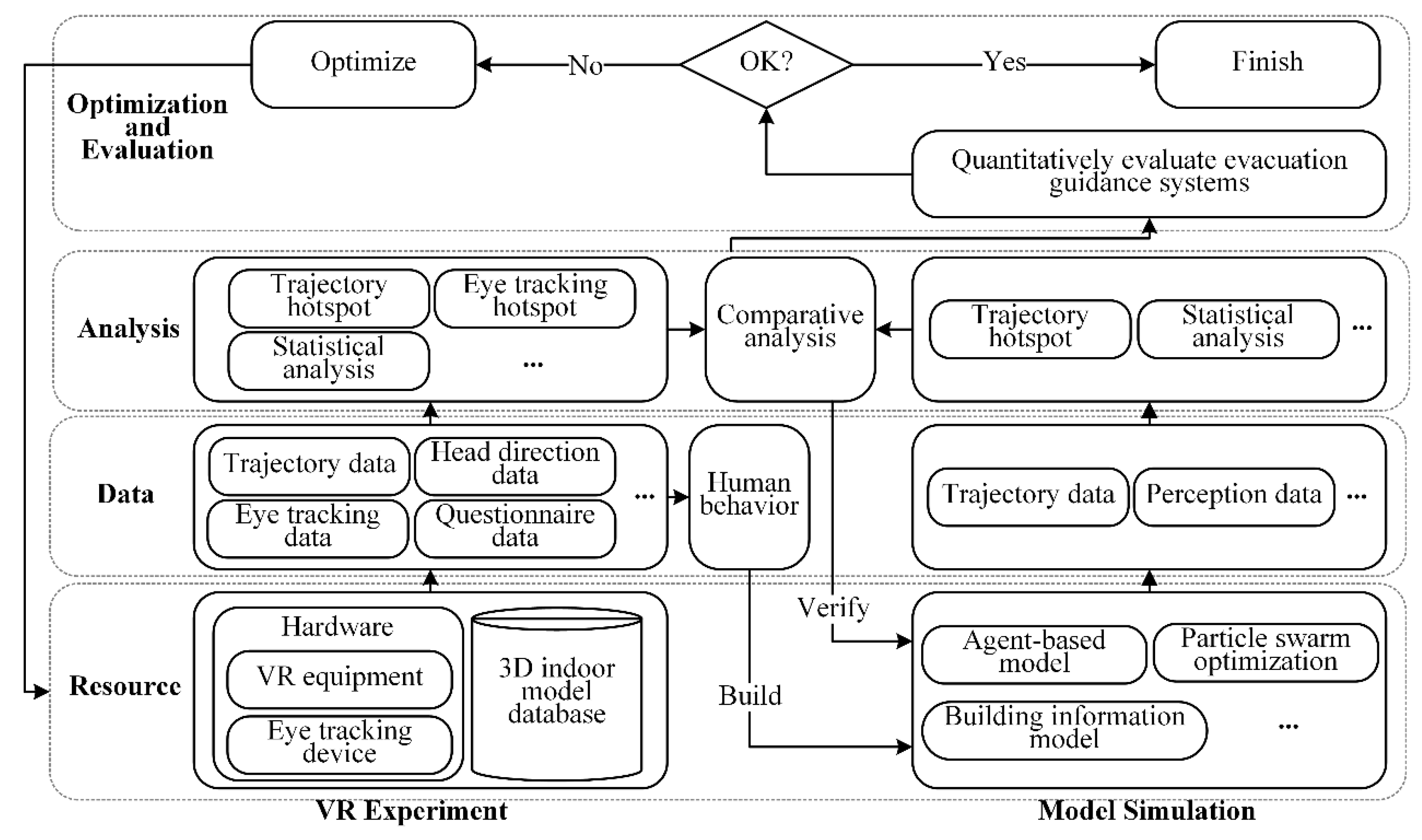

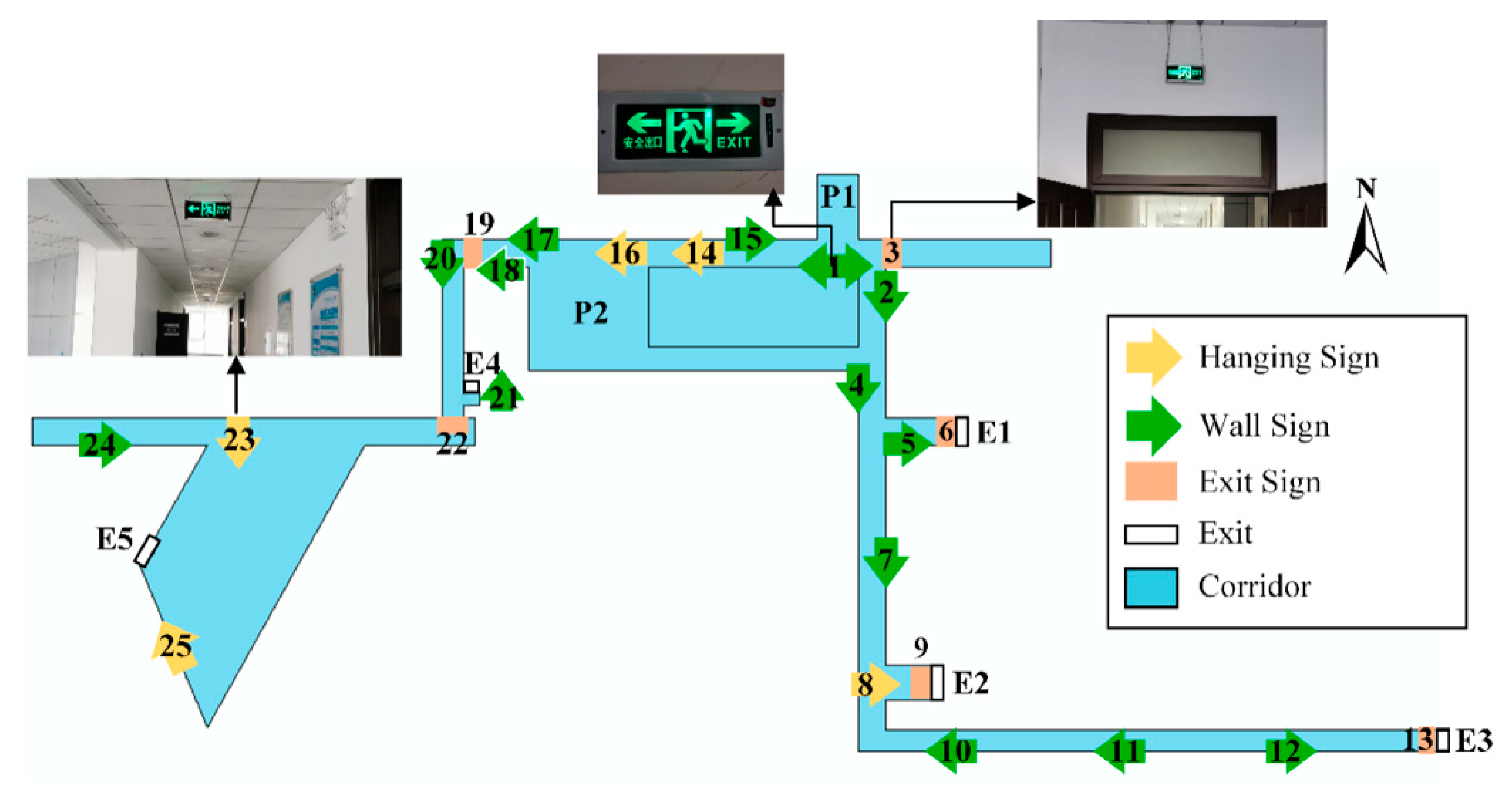
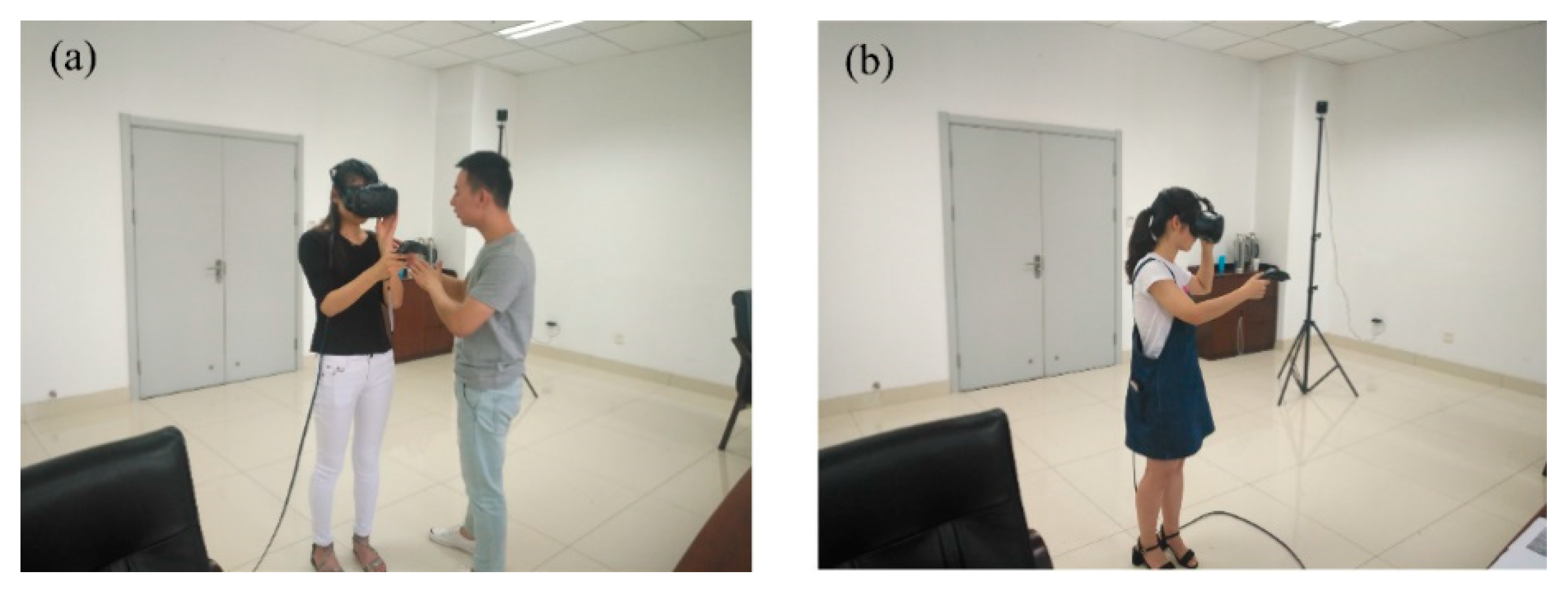






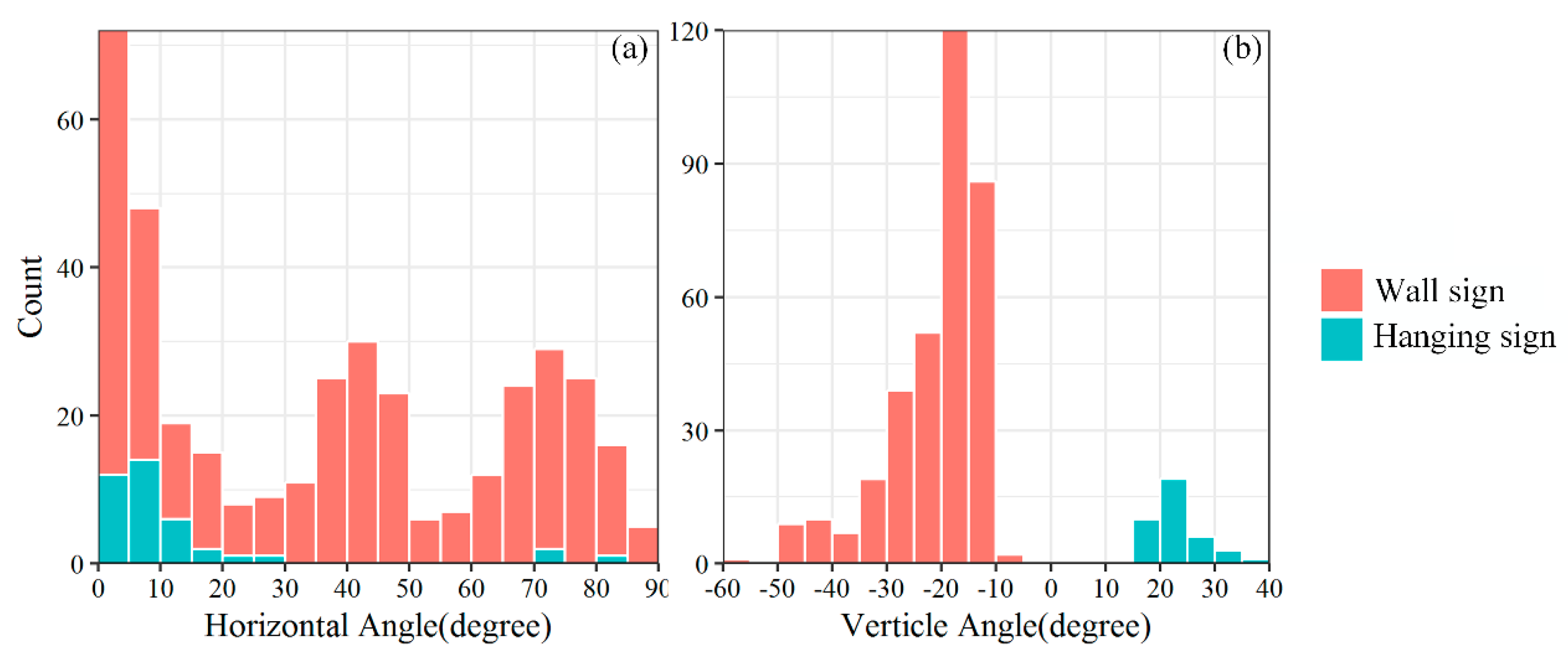
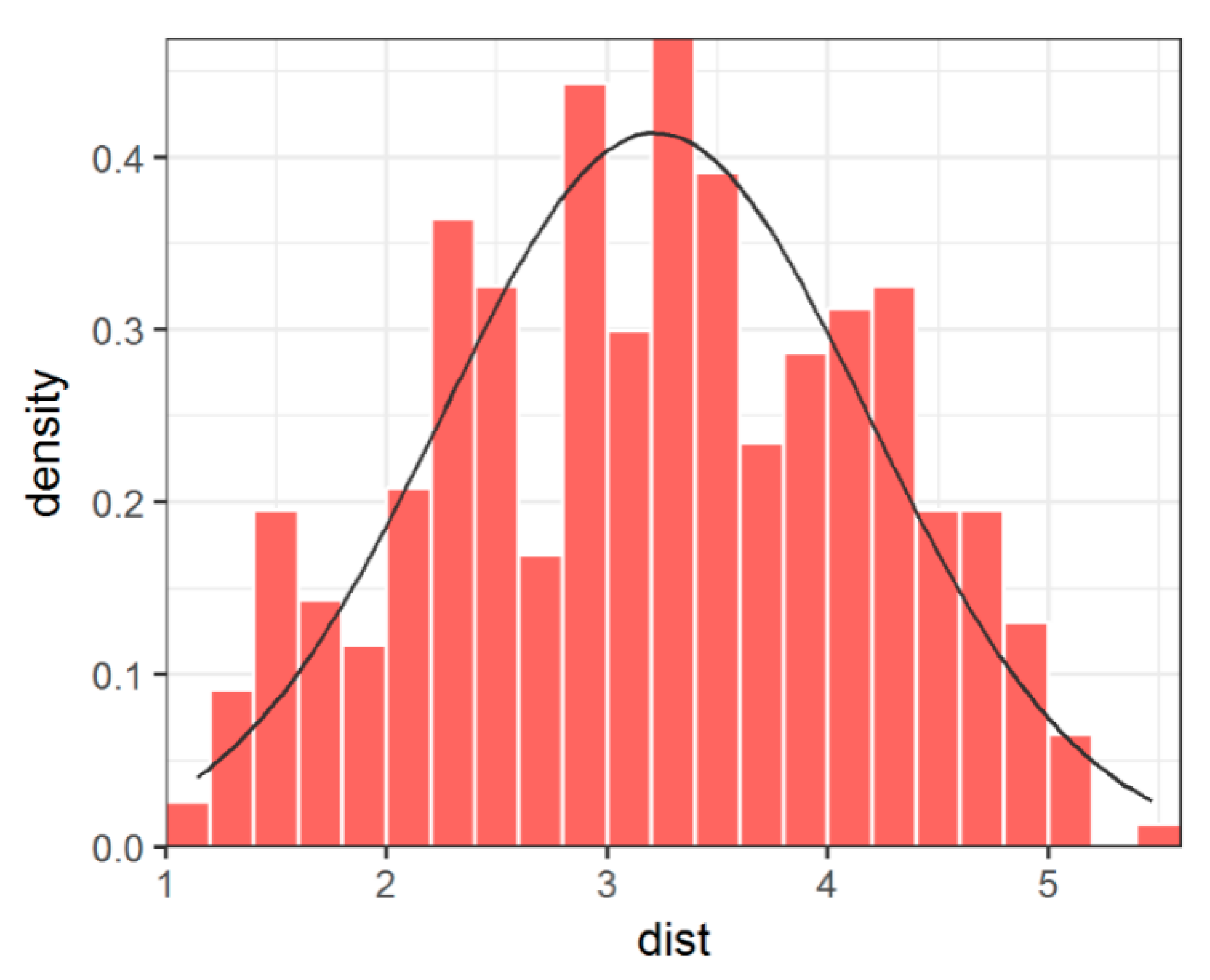
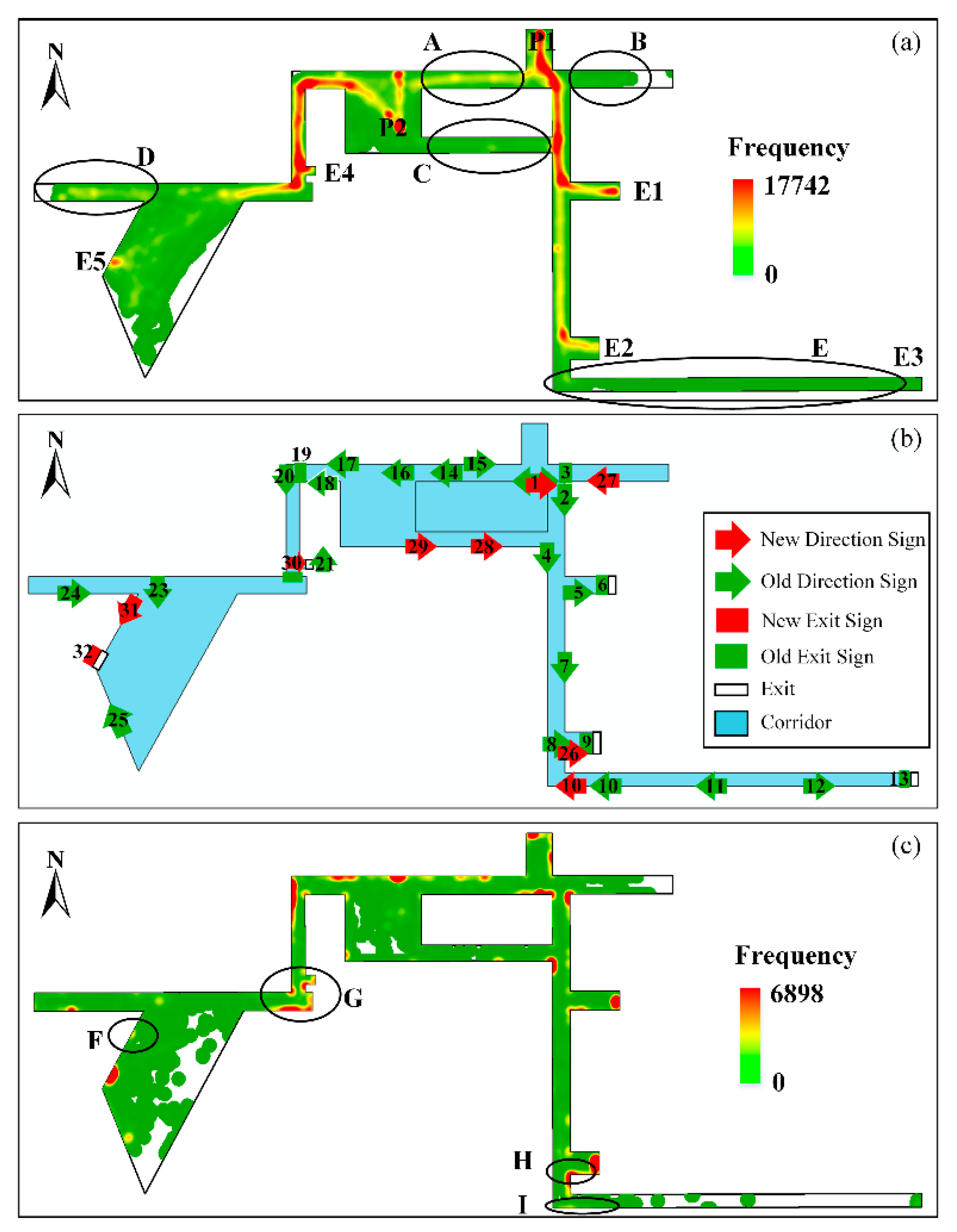

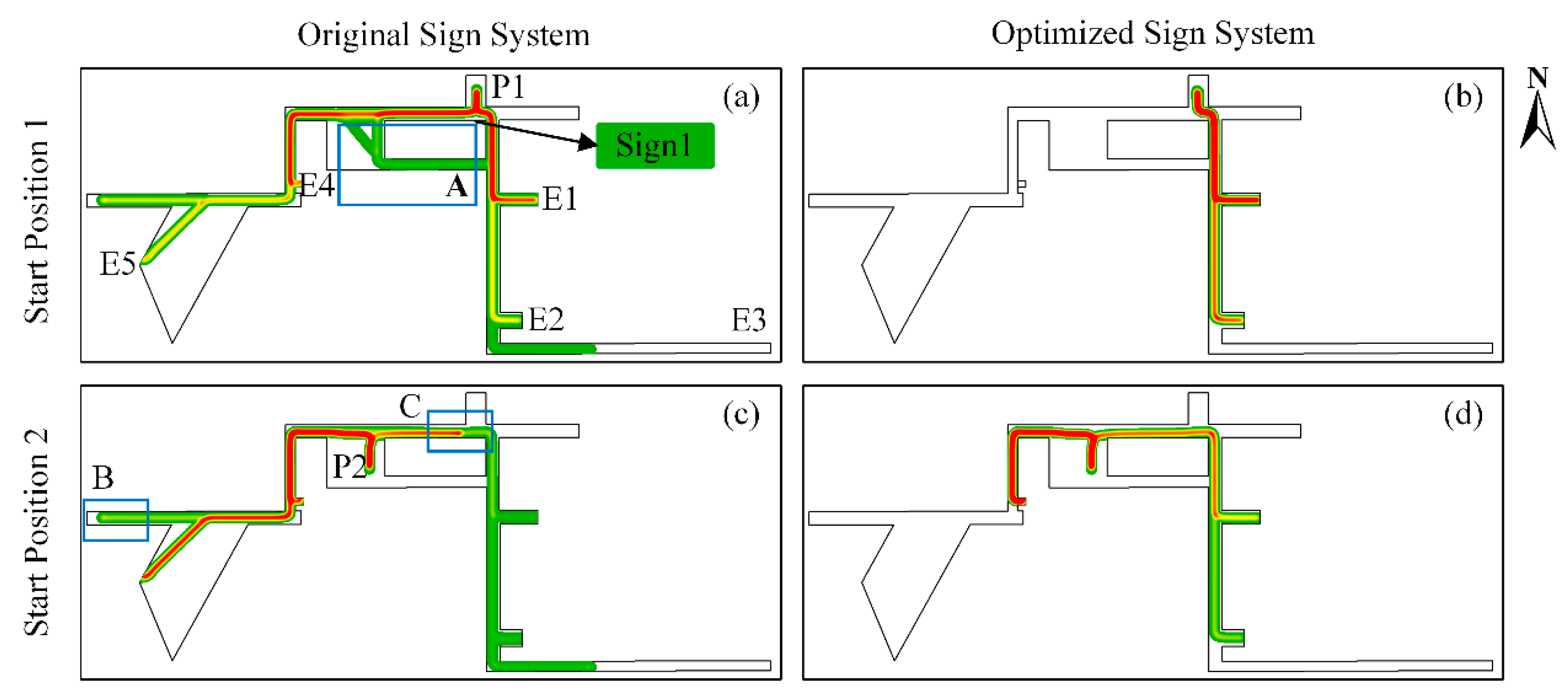
| Position | Pearson Correlation Coefficient | p-Value |
|---|---|---|
| P1 of the original sign system | 0.479 | <0.05 |
| P2 of the original sign system | 0.526 | <0.05 |
| P1 of the optimized sign system | 0.639 | <0.05 |
| P2 of the optimized sign system | 0.676 | <0.05 |
| Position | Resource | Time (s) | p-Value of t-Test | p-Value of F-Test | Distance (m) | p-Value of t-Test | p-Value of F-Test |
|---|---|---|---|---|---|---|---|
| P1 | Original VR | 41.2 | 0.48 | 0.73 | 57.51 | 0.89 | 0.47 |
| Original Model | 38.78 | 56.85 | |||||
| Optimized VR | 28.67 | 0.12 | 0.16 | 38.89 | 0.24 | 0.79 | |
| Optimized Model | 24.5 | 35.92 | |||||
| P2 | Original VR | 59.91 | <0.05 * | <0.05 * | 78.57 | <0.05 * | <0.05 * |
| Original Model | 40.8 | 59.69 | |||||
| Optimized VR | 33.95 | 0.09 | 0.04 * | 43.71 | 0.87 | 0.2 | |
| Optimized Model | 29.57 | 43.16 |
Publisher’s Note: MDPI stays neutral with regard to jurisdictional claims in published maps and institutional affiliations. |
© 2021 by the authors. Licensee MDPI, Basel, Switzerland. This article is an open access article distributed under the terms and conditions of the Creative Commons Attribution (CC BY) license (http://creativecommons.org/licenses/by/4.0/).
Share and Cite
Huang, L.; Gong, J.; Li, W. A Perception Model for Optimizing and Evaluating Evacuation Guidance Systems. ISPRS Int. J. Geo-Inf. 2021, 10, 54. https://0-doi-org.brum.beds.ac.uk/10.3390/ijgi10020054
Huang L, Gong J, Li W. A Perception Model for Optimizing and Evaluating Evacuation Guidance Systems. ISPRS International Journal of Geo-Information. 2021; 10(2):54. https://0-doi-org.brum.beds.ac.uk/10.3390/ijgi10020054
Chicago/Turabian StyleHuang, Lin, Jianhua Gong, and Wenhang Li. 2021. "A Perception Model for Optimizing and Evaluating Evacuation Guidance Systems" ISPRS International Journal of Geo-Information 10, no. 2: 54. https://0-doi-org.brum.beds.ac.uk/10.3390/ijgi10020054





